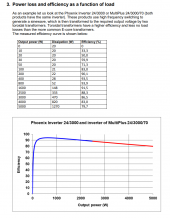tab783
New Member
My apologies if this topic has been beat to death but I'm starting to pick components for a solar system on my 50A RV. It has no 240V appliances so there are just two separate 120V buses in the distribution panel.
I have a little confusion regarding which inverter to use. I know the Victron Multiplus II 2x120 will automatically handle 50A vs 30A shore power but is there an alternative Growatt/EG4/MPP Solar inverter that provides the same functionality or could this be implemented with a mechanical bypass switch for an inverter that doesn't inherently have this functionality?
I was originally thinking of going with the EG4 6500EX-48 for it's high 500Voc since I'm planning over 4kW of panels but noticed it has a single 120V input and output. This seems like it would be an issue when trying to utilize 50A shore power or my 8kW genset which provide L1/L2 at 120V.
For reference, my rough plans:
AC Inputs: 50A shore or 8kW Genset (onboard transfer switch decides)
Solar: 4kW+
Batteries: 2-3 EG4-LL 48V100aH
Inverter: EG4 6500EX-48???
I have a little confusion regarding which inverter to use. I know the Victron Multiplus II 2x120 will automatically handle 50A vs 30A shore power but is there an alternative Growatt/EG4/MPP Solar inverter that provides the same functionality or could this be implemented with a mechanical bypass switch for an inverter that doesn't inherently have this functionality?
I was originally thinking of going with the EG4 6500EX-48 for it's high 500Voc since I'm planning over 4kW of panels but noticed it has a single 120V input and output. This seems like it would be an issue when trying to utilize 50A shore power or my 8kW genset which provide L1/L2 at 120V.
For reference, my rough plans:
AC Inputs: 50A shore or 8kW Genset (onboard transfer switch decides)
Solar: 4kW+
Batteries: 2-3 EG4-LL 48V100aH
Inverter: EG4 6500EX-48???




